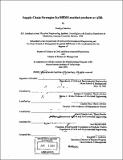| dc.contributor.advisor | Stephen D. Senturia and Charles Fine. | en_US |
| dc.contributor.author | Sanchez, Rodrigo, 1973- | en_US |
| dc.contributor.other | Sloan School of Management. | en_US |
| dc.date.accessioned | 2006-03-24T18:01:10Z | |
| dc.date.available | 2006-03-24T18:01:10Z | |
| dc.date.copyright | 2002 | en_US |
| dc.date.issued | 2002 | en_US |
| dc.identifier.uri | http://hdl.handle.net/1721.1/29898 | |
| dc.description | Thesis (S.M.)--Massachusetts Institute of Technology, Dept. of Civil and Environmental Engineering; and, (S.M.)--Massachusetts Institute of Technology, Sloan School of Management, 2002. | en_US |
| dc.description | Includes bibliographical references (p. 64-65). | en_US |
| dc.description.abstract | MEMS (Micro-Electronic Mechanical Systems) is an emerging and promising technology. It offers the promise of unique competitive advantages to companies able master the difficulties associated with it. One of those difficulties is manufacturing. Each new product poses a very unique fabrication challenge. The development of the fabrication process has to go hand in hand with the development of the product itself, and sometimes even drives it. ABB has identified MEMS technologies as a platform to improve its product line. It is currently developing a series of new products that will be enabled by MEMS. It has decided to outsource most if not all of the fabrication of its components. This presents it with a series of challenges related to the design and management of the associated supply-chain. This thesis focuses on the challenges faced by ABB in this journey. More specifically, the thesis will: ** Give a brief description of the efforts at ABB to incorporate MEMS technologies into their product portfolio; ** Report on the work done to survey the existing vendor pool for process competencies and to develop methods to find matches with ABB product needs; ** Describe the development of a database to anchor ABB's MEMS knowledge base; ** Analyze and describe the tactical options open for ABB in the design of its Supply Chain for MEMS Manufacturing; ** Identify the factors for success and the potential pitfalls going forward for ABB. | en_US |
| dc.description.statementofresponsibility | by Rodrigo Sanchez. | en_US |
| dc.format.extent | 65 p. | en_US |
| dc.format.extent | 4277460 bytes | |
| dc.format.extent | 4282521 bytes | |
| dc.format.mimetype | application/pdf | |
| dc.format.mimetype | application/pdf | |
| dc.language.iso | eng | en_US |
| dc.publisher | Massachusetts Institute of Technology | en_US |
| dc.rights | M.I.T. theses are protected by copyright. They may be viewed from this source for any purpose, but reproduction or distribution in any format is prohibited without written permission. See provided URL for inquiries about permission. | en_US |
| dc.rights.uri | http://dspace.mit.edu/handle/1721.1/7582 | |
| dc.subject | Civil and Environmental Engineering. | en_US |
| dc.subject | Sloan School of Management. | en_US |
| dc.title | Supply-chain strategies for MEMS-enabled products at ABB | en_US |
| dc.title.alternative | Supply-chain strategies for microelectromechanical systems-enabled products at Asea Brown Boveri Ltd. | en_US |
| dc.type | Thesis | en_US |
| dc.description.degree | S.M. | en_US |
| dc.contributor.department | Massachusetts Institute of Technology. Department of Civil and Environmental Engineering | |
| dc.contributor.department | Sloan School of Management | |
| dc.identifier.oclc | 50616719 | en_US |
